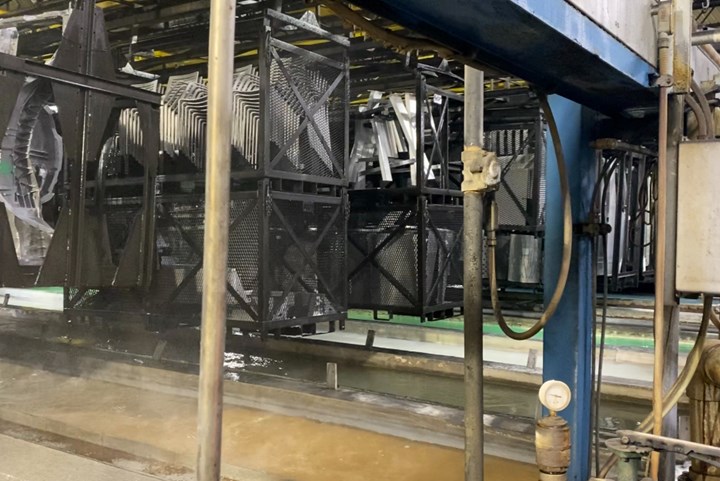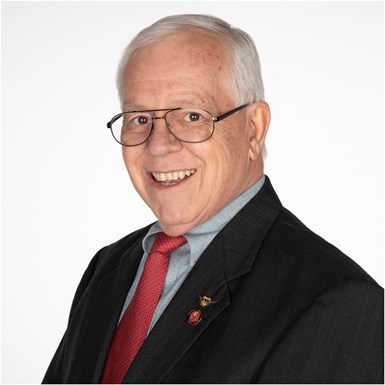Installing an Ecoat Line
Thinking of investing in electrocoating capabilities? George Lovell, coatings plant manager for Lippert, discusses considerations you should keep in mind as you add your ecoat line.
#ask the expert #basics

The ecoat line at Lippert Plant 72 in Elkhart, Ind.
Photo Credit: Products Finishing
Q: I’m thinking of adding an electrocoating line to my facility. What considerations should I keep in mind?
A: Things to consider as you make the move to ecoating of parts in your plant: First ask these two questions — vendors will need to have answers to the following questions:
Featured Content
- Are you going to be a captive shop and only paint your own parts?
- Are you going to be a job shop painter and provide a service for the e-coating of parts?
The good news is you are entering into a mature industry that has established suppliers that know how to build ecoat systems and supporting systems. Pick your suppliers early and carefully, they will be a valued asset, the ecoat paint system is designed to meet your requirements.
Cleaning and pretreatment vendors
Cleaning/pretreatment suppliers are essential when designing an ecoat system. Engage them early on.
Cleaning/pretreatment suppliers have a vast knowledge of what can and cannot be used on parts from a cleaning standpoint. A word of caution — WD-40 should never be used on parts to be ecoated.
Cleaning/removing of compounds used to manufacture parts that will be ecoated are important too; allow for pretreatments to be applied, and to protect the ecoat paint tank from becoming contaminated. Think of it this way, your largest liquid asset in the system is the ecoat paint tank and represents 90% of the total cost of the liquids used in the system. Replacing the paint in an ecoat line is an expensive proposition.
Paint vendors
There are several paint suppliers that provide ecoat paints and system design help. Bluntly put, use them. They have been supplying ecoat in the industry for a long time. Some date back to the early 1960s.
Ecoat paint vendors have experts on staff that will ensure the ecoat system designed by equipment vendors will be able to use their paint correctly and produce quality parts.
Equipment vendors
There are many exceptionally good equipment vendors who support the ecoat industry. You want someone who can provide a turn-key system while working with your paint and pretreatment vendors.
Ecoat systems should be looked at as sub-systems required to support operations.
Circulating sub-system provides tank agitation to keep the paint from settling out and for cooling the ecoat paint in the tank to the paint vendor’s recommendation.
Tank filtration is necessary to remove contaminates that can get in the ecoat paint. Filtration also protects the ultrafilter sub-system.
Ultrafiltration sub-system is necessary to help control ecoat bath operational parameters set by your paint vendor.
Electrical sub-system uses rectifiers to convert AC to DC current, anolyte cells that contain anodes that apply the electrical energy to the ecoat paint. Sizing of this system is critical — check with your paint vendor resource.
It is important that the rectifier produces a clean conversion from AC to DC current with a 2 to 5% ripple.
Ultrafiltration sub-system uses in-line filters to remove contaminates before they can reach the ultrafilter membranes. Ultrafilter membranes have microscopic openings that separate permeate from the circulating paint to create rinsing liquids and to remove contamination from the ecoat paint tank. Check with your paint vendor for their recommendation as to the amount of permeate they require to support your proposed production volumes.
Cure/bake oven sub-systems are used to provide final cure of the ecoat paint. There are many types of bake ovens to be considered and their design is all driven by metal mass to be cured. For example, your paint vendor may require a cure time of 20 minutes at 325°F metal temperature. This heaviest metal mass in the bake oven will need to meet the minimum temperature. You will typically see the oven designed with time in the oven to be in the 40-60-minute range.
Adding overhead fans in the cure/bake oven helps provide excellent heat distribution around the parts and can shorten the total time in the cure/bake ovens, resulting in lower operating costs.
Minimum time at temperature as recommended by your paint vendor provides the temperature required to cross-link the paint.
Make sure it is understood how a cure/bake oven works. For example, infrared ovens (IR) are line-of-sight. If the IR energy cannot see the area of a complicated shaped part, there is a risk that areas of the part may not see enough IR energy to meet minimum time at temperature for cross-linking of the paint. In this case, adding overhead fans in an IR-type cure/bake oven would help circulate the heat more uniformly around the part.
References
Ask your chosen suppliers for references that can be contacted. References should include the maintenance manager, people with first-hand experience maintaining all of the subsystems and plant engineering.
Make sure to ask about uptime on their line, and on-time delivery of equipment installation.
About the Author

George Lovell
George Lovell is the product manager for coatings at Lippert Plant #72. Visit lippertcomponents.com.
RELATED CONTENT
-
Sustainability, Electrification and Mobility
Industry events like ECOAT are good indicators of the trends that are top of mind for those in manufacturing.
-
Looking Back to Look Forward
Products Finishing reflects on a year of reporting on the surface finishing industry and looks ahead to what may be in store for 2023.
-
Coatings Plant Evolves with Market Trends
Expanding its focus from exclusively serving the RV industry, one of this company’s stand-alone coatings plant has successfully extended its services to additional markets.


















